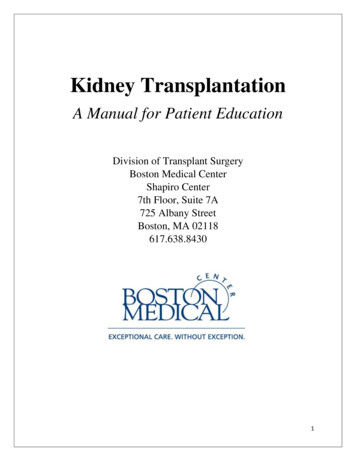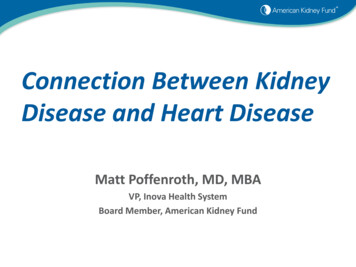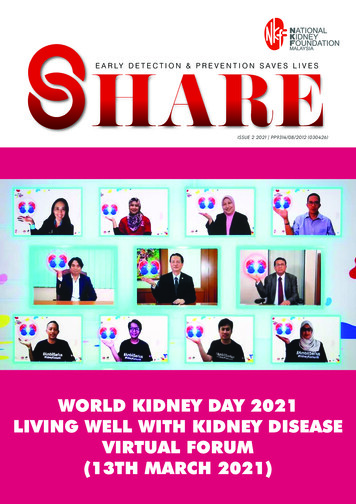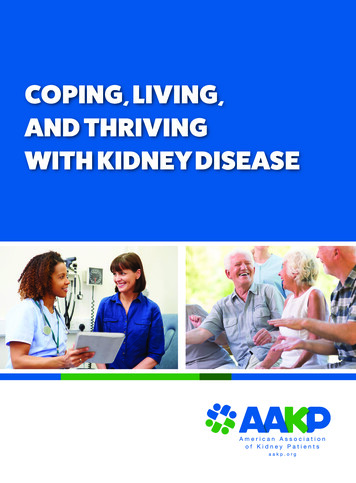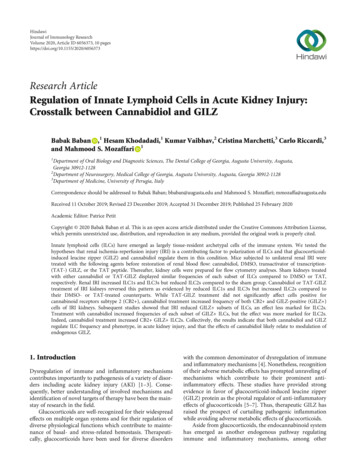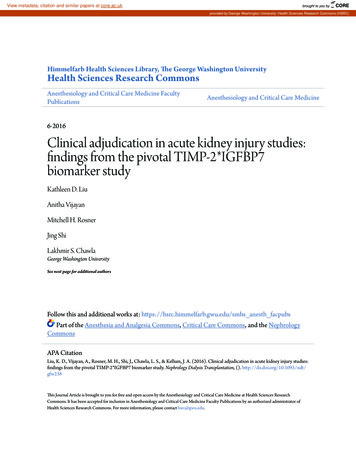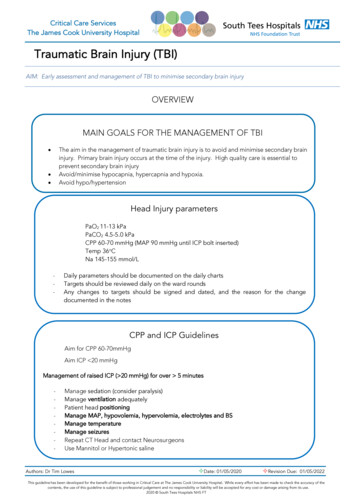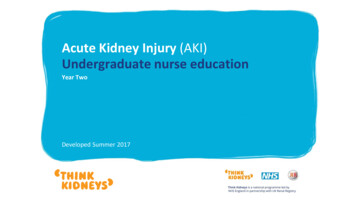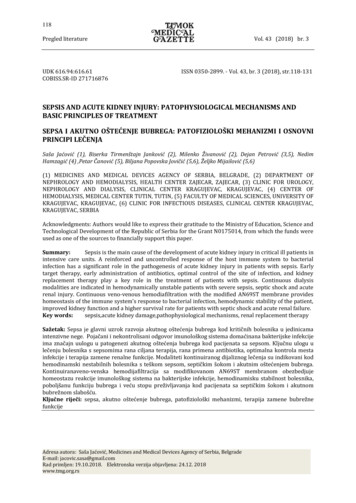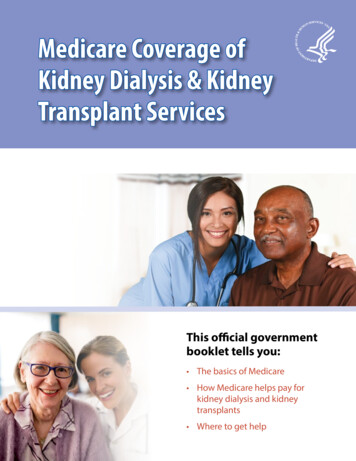
Transcription
(2021) 21:290Kim et al. BMC 862-xOpen AccessRESEARCHImpact of acute kidney injury on mortalityin patients with acute variceal bleedingJae Heon Kim1,3†, Chang Bin Im3†, Sang Soo Lee1,2,3*, Hankyu Jeon1,3, Jung Woo Choi1, Hee Jin Kim1,2,3,Ra Ri Cha1,2,3, Hyun Chin Cho1,2, Jae Min Lee1,2,3, Chang Yoon Ha1,2, Hyun Jin Kim1,2,3, Tae Hyo Kim1,2,Woon Tae Jung1,2 and Ok‑Jae Lee1,2AbstractBackground: The effect of acute kidney injury (AKI) on patients with acute variceal bleeding (AVB) using the recentlyproposed International Club of Ascites (ICA) criteria is unclear. This study aimed to evaluate the incidence of AKI usingthe ICA criteria and factors associated with the outcomes in cirrhotic patients with AVB.Methods: This retrospective cohort study included data of cirrhotic patients with AVB from two centers in Korea. Theassociation of the ICA criteria for AKI with 6-week mortality was analyzed through univariate and multivariate analysesusing the Cox proportional hazard model.Results: In total, there were 546 episodes of AVB in 390 patients, of which 425 and 121 episodes were due to esopha‑geal and gastric variceal bleeding, respectively. Moreover, 153 patients fulfilled the ICA criteria for AKI, and 64, 30,39, and 20 patients were diagnosed with stages 1a, 1b, 2, and 3, respectively. Conversely, 97 patients developed AKIwithin 42 days as per the conventional criteria. The 6-week mortality rate was significantly higher in patients with ICAAKI than in patients without ICA-AKI; the occurrence of ICA-AKI was an independent factor for predicting the 6-weekmortality.Conclusion: The ICA criteria could help diagnose renal dysfunction earlier, and presence of AKI is a predictor of mor‑tality in patients with cirrhosis and AVB.Keywords: Acute kidney injury, Liver cirrhosis, Acute variceal bleeding, Mortality, International Club of Ascites criteriaBackgroundAcute variceal bleeding (AVB) is one of the most lifethreatening complications of portal hypertension and amajor cause of death in patients with liver cirrhosis [1,2]. Over the past two decades, therapeutic developmentsin the management of AVB have resulted in markedimprovement in the mortality rate in the initial 6 weeks[3, 4]. However, despite advances in the management*Correspondence: 3939lee@naver.com†JaeHeon Kim and ChangBin Im have contributed equally to this work1Department of Internal Medicine, Gyeongsang National UniversityHospital, Gyeongsang National University School of Medicine, Jinju,Gyeongnam, Republic of KoreaFull list of author information is available at the end of the articleapproaches for AVB, the 6-week mortality rate remainshigh at 10–20% [1, 5]. Several factors increase the risk ofmortality in patients with AVB: Child–Pugh score, modelof end-stage liver disease (MELD) score, hepatocellularcarcinoma (HCC), hypovolemic shock, hepatic venousgradient, active bleeding at endoscopy, and renal dysfunction [4, 6–8].Renal dysfunction occurs in approximately 20% of hospitalized patients with cirrhosis [9–12]. Acute kidneyinjury (AKI) may have a significant effect on the mortality of patients with liver cirrhosis and AVB. Recently,the International Club of Ascites (ICA) proposed newdiagnostic criteria for AKI in patients with cirrhosis [13],which defines AKI as either an increase of baseline serum The Author(s) 2021. Open Access This article is licensed under a Creative Commons Attribution 4.0 International License, whichpermits use, sharing, adaptation, distribution and reproduction in any medium or format, as long as you give appropriate credit to theoriginal author(s) and the source, provide a link to the Creative Commons licence, and indicate if changes were made. The images orother third party material in this article are included in the article’s Creative Commons licence, unless indicated otherwise in a credit lineto the material. If material is not included in the article’s Creative Commons licence and your intended use is not permitted by statutoryregulation or exceeds the permitted use, you will need to obtain permission directly from the copyright holder. To view a copy of thislicence, visit http:// creat iveco mmons. org/ licen ses/ by/4. 0/. The Creative Commons Public Domain Dedication waiver (http:// creat iveco mmons. org/ publi cdoma in/ zero/1. 0/) applies to the data made available in this article, unless otherwise stated in a credit line to the data.
Kim et al. BMC Gastroenterol(2021) 21:290creatinine level by 0.3 mg/dL or a 50% increase frombaseline levels. A recent study showed that AKI definedusing the ICA criteria commonly occurs (41%) in patientswith gastric variceal bleeding [14]. In addition, the ICAAKI criteria could help diagnose renal dysfunction earlier than the conventional criteria and predict mortalityin patients with liver cirrhosis and gastric variceal bleeding. This could have a significant effect on mortalityin patients with esophageal and gastric variceal bleeding. However, few studies have diagnosed AKI definedaccording to the ICA criteria in patients with esophagealvariceal bleeding. Therefore, this retrospective cohortstudy aimed to investigate the incidence of AKI as perthe new ICA criteria in cirrhotic patients with esophagealand gastric variceal bleeding and to investigate the factorsrelated to the 6-week mortality.Material and methodsStudy populationFrom January 2015 to December 2019, a total of 640 consecutive episodes of AVB in 463 patients with cirrhosisat two centers were screened for enrollment. The inclusion criteria were as follows: (1) aged 18 years, (2) livercirrhosis, and (3) acute esophageal or gastric varicealbleeding confirmed by endoscopy. The exclusion criteria were as follows: (1) loss to follow-up within 3 monthsafter variceal bleeding (26 episodes), (2) end-stage renaldisease (4 episodes), and (3) recent variceal bleedingwithin 3 months (64 episodes in 43 patients). Laboratorytest results and comorbidities, including diabetes mellitus and hypertension, were retrieved from the medicalrecords of patients with AVB. The patients’ medical histories were reviewed to identify demographic, laboratory,and endoscopic data.The Institutional Review Boards of GyeongsangNational University Changwon Hospital (IRB No. 201707-003) and Gyeongsang National University Hospital(IRB No. 2015-01-008) approved this study. The informedconsent was waived due to the retrospective design ofthis study, as determined by the Institutional ReviewBoards.Definition and treatmentMedical charts were retrospectively reviewed to determine death and AKI occurrence within 6 weeks. Forpatients with multiple episodes of AVB during the studyperiod, all episodes except AVB episodes within the last3 months were considered for analyses of 6-week mortality. The index date in this analysis was defined as the dateof the first visit to the hospital for AVB. After enrollment,all patients underwent laboratory investigations, including serum creatinine, at least every 2–3 days.Page 2 of 9Liver cirrhosis was defined as the (1) presence of clinical signs of portal hypertension manifested as varices,ascites, or hepatic encephalopathy or (2) compatible imaging findings accompanied by thrombocytopenia( 100,000/µL). Variceal bleeding was defined as hemorrhage from esophageal or gastric varices confirmed byendoscopy. AVB was defined as bleeding in a patient withliver cirrhosis and hematemesis within the last 24 h ofpresentation and/or ongoing melena within the last 24 h[5]. Active variceal bleeding was defined as spurting oroozing at the time of endoscopy [5].Endoscopy was performed within 24 h after admissionin all patients. Endoscopic variceal ligation (EVL) wasperformed for treatment of bleeding from esophagealvarices or gastroesophageal varices type 1, whereas endoscopic variceal obturation (EVO) with histoacryl wasperformed for the treatment of bleeding from gastroesophageal varices type 2 or isolated gastric varices. Allendoscopic procedures were performed by endoscopistswith 5 years of experience. Balloon-occluded retrogradetransvenous obliteration (BRTO) was used in isolatedgastric varices as per the clinical decision of the physicians. Prophylactic antibiotics and vasoconstrictors suchas terlipressin or somatostatin were started as soon asvariceal bleeding occurred. Balloon tamponade was usedfor refractory esophageal bleeding despite immediateendoscopic therapy. However, emergency intrahepaticportosystemic shunt was not available in our centers.Failure to control bleeding was defined as death or theneed to change treatment defined by one of the following events: (1) fresh hematemesis or nasogastric aspiration of 100 mL of fresh blood 2 h after the start of atherapeutic endoscopy, (2) development of hypovolemicshock, or (3) 3 g drop in hemoglobin within 24 h if notransfusion is administered [1, 15]. Variceal rebleedingwas defined as recurrent melena or hematemesis afterday 5 in any of the following criteria: (1) hospital admission, (2) blood transfusion, (3) 3 g drop in hemoglobin, or(4) death within 6 weeks [15, 16].Acute kidney injuryThe ICA criteria defined AKI as an increase of 0.3 mg/dL within 48 h or 50% of baseline in serum creatininelevels within the previous 7 days [13]. Baseline serumcreatinine was defined as the most recent value of serumcreatinine within 3 months before admission, becauseserum creatinine before admission was barely availablein patients developing AVB. In patients without serumcreatinine value available in the 3 months before admission, the last stable level of serum creatinine between3 months and 1 year was used as the baseline. If preadmission serum creatinine values were not available, thecreatinine level at admission was used as the baseline [9,
Kim et al. BMC Gastroenterol(2021) 21:29011]. Conventional AKI was defined as a 50% increase inserum creatinine with a final value above 1.5 mg/dL.AKI stages were defined as follows [13]: AKI stage 1,an increase in serum creatinine 0.3 mg/dL or increasein serum creatinine 1.5-fold to twofold from baseline;AKI stage 2, an increase in serum creatinine by 2 tothreefold from baseline; and AKI stage 3, an increase inserum creatinine by threefold from baseline or serumcreatinine 4.0 mg/dL with an acute increase of 0.3 mg/dL or need for renal replacement therapy (RRT). Patientsin stage 1 were further subdivided into stage 1a (serumcreatinine 1.5 mg/dL) and stage 1b (serum creatinine 1.5 mg/dL) [12]. If the patients experienced multiple episodes of AKI within 42 days, only the first episodewas considered. AKI progression was defined as progression to a higher AKI stage and/or need for RRT duringhospitalization.The cause of AKI was classified into three groups: (1)pre-renal AKI, (2) hepatorenal syndrome (HRS)-AKI,and (3) intrinsic-renal AKI. The diagnostic criteria ofHRS were defined using the ICA criteria [13].Statistical analysisThe Mann–Whitney U test was used to analyze differences in continuous variables between groups. Fisher’sexact and Pearson’s chi-square tests were used to analyzequalitative data. Survival curves for the development of6-week survival were calculated using the Kaplan–Meiermethod and compared using the log-rank test. Univariate and multivariate analyses were conducted using theCox proportional regression model to identify potentialfactors associated with AKI development and 6-weekmortality. The components of the Child–Pugh scores andMELD scores were excluded in the multivariate analysesto avoid collinearity. The risk was expressed as hazardratio (HR) and 95% confidence interval (CI). A two-sidedP value of 0.05 was considered significant for all analyses. Statistical analyses were conducted using the PASWsoftware (version 18; SPSS Inc, Chicago, IL).ResultsPatient characteristicsIn total, 546 episodes in 390 patients with AVB wereselected for analysis (Fig. 1). Baseline characteristics of546 episodes with AVB are shown in Table 1. The medianpatient age was 58 years, and 84.1% of the patients weremale. The primary etiologies of cirrhosis were alcoholconsumption (64.7%), hepatitis B virus (19.8%), hepatitisC virus (7.1%), and cryptogenic causes (8.4%). Bleedingsources were esophageal varices in 425 (77.8%) and gastric varices in 121 (22.2%) patients. EVL, EVO, and BRTOwere performed in 450, 90, and 6 patients with AVB,respectively. Initial endoscopy revealed active varicealPage 3 of 9bleeding in 232 patients (42.5%). Failure to control bleeding was noted in 32 patients (5.9%). Variceal rebleedingwas observed in 38 patients (7.0%) after day 5.AKI developmentOf the 546 episodes, 153 (28.0%) fulfilled the ICA criteria for AKI. The composition of baseline creatinine isshown in Additional file 1: Table S1. AKI was presentin 128 (83.7%) patients at admission, whereas 7 (4.6%)had AKI beyond 5 days of hospitalization. Patients withAKI had higher median serum creatinine level at admission (1.12 mg/dL vs. 0.73 mg/dL; P 0.001) and baseline serum creatinine levels (0.75 mg/dL vs. 0.71 mg/dL; P 0.009) than patients without AKI. At the time ofAKI diagnosis, 64 (41.8%), 30 (19.6%), 39 (25.5%), and20 (13.1%) patients had initial AKI at stages 1a, 1b, 2,and 3, respectively (Table 2). The median serum creatinine levels at the time of AKI diagnosis were 1.19 mg/dL, 2.03 mg/dL, 1.70 mg/dL, and 2.70 ng/dL in stages 1a,1b, 2, and 3, respectively. During hospitalization, peakAKI stages 1a, 1b, 2, and 3 were seen in 56 (36.6%), 27(17.6%), 37 (24.2%), and 33 (21.6%) patients, respectively.Among the 153 patients with AKI, AKI progression wasobserved in 30 (19.6%) patients, and 19 (12.4%) patientsneeded RRT. The 6-week mortalities as per the progression of AKI are shown in Fig. 2. In 153 patients with AKI,progression of AKI was markedly more common amongnon-survivors (53.5%) than among survivors (6.4%;P 0.001) (Table 2). The causes of AKI were (1) prerenalAKI in 131 (85.6%) patients, (2) HRS-AKI in 18 (11.8%)patients, and (3) intrinsic renal AKI in 4 (2.6%) patients(Table 2).In the univariate analysis, risk factors associated withAKI development were HCC (HR, 1.95; P 0.001), failure to control bleeding (HR, 2.78; P 0.001), use of diuretics (HR, 1.39; P 0.048), initial hemoglobin level (HR,0.83 per g/dL; P 0.001), Child–Pugh score (HR, 1.26 perpoint; P 0.001), and MELD score (HR, 1.10 per point;P 0.001). In the multivariate analysis for AKI development, the risk factors were HCC (HR, 1.70; P 0.007),hemoglobin level (HR, 0.91 per g/dL; P 0.026), andMELD score (HR, 1.11 per point; P 0.001) (Table 3).Effect of AKI on survivalDuring the study period, the overall mortality rate was9.3% (n 51) at 6 weeks. The 6-week mortality rate washigher in patients with AKI (28.1%) than in patients without AKI (2.0%, P 0.001) (Fig. 2A). In addition, patientswith initial AKI stage 1a (9.4%; P 0.001), stage 1b(46.7%; P 0.001), stage 2 (25.6%; P 0.001), and stage3 (65.0%; P 0.001) had higher 6-week mortality rates(Fig. 2B) than those without AKI (2.0%). Regardless ofthe initial AKI stage, patients with AKI progression had
Kim et al. BMC Gastroenterol(2021) 21:290Page 4 of 9Fig. 1 Flow chart. AKI, acute kidney injury; ESRD, end-stage renal diseasehigher 6-week mortality rate than those without AKIprogression (Fig. 3). Patients with AKI stage 1b did nothave a significantly higher 6-week mortality rate (46.7%;P 0.080) than those with initial AKI stage 2 (25.6%).Moreover, the median serum creatinine level at diagnosisin patients with initial AKI 1b (2.03 mg/dL) was higherthan that in those with stage 2 (1.70 mg/dL; P 0.001).According to the conventional diagnostic criteria ofAKI, 97 (17.8%) patients developed AKI within 42 days.Patients with conventional AKI diagnosis had higher6-week mortality rate (n 40, 41.2%; P 0.001) thanthose without (n 11, 2.4%). There were 56 patients whodid not meet the conventional AKI criteria but did meetthe new ICA-AKI criteria. All 56 of these patients hadAKI stage 1b, with 3 of the 56 dying within 42 days.Factors associated with 6-week mortality on the univariate analysis were HCC (HR, 4.33; P 0.001), failure tocontrol bleeding (HR, 14.03; P 0.001), initial hemoglobinlevel (HR, 0.85 per g/dL; P 0.031), Child–Pugh score (HR,1.62 per point; P 0.001), MELD score (HR, 1.17 per point;P 0.001), and AKI (HR 15.69; P 0.001). Factors associatedwith 6-week mortality in the multivariate analysis wereHCC (HR, 3.29; P 0.001), failure to control bleeding (HR,4.95; P 0.001), MELD score (HR, 1.10 per point; P 0.001),and AKI (HR, 3.95; P 0.002) (Table 4) (Additional file 1:Table S2).
Kim et al. BMC Gastroenterol(2021) 21:290Page 5 of 9Table 1 Baseline characteristics of patients with acute variceal bleeding (n 546)All patients (n 546)No AKI (n 393)AKI (n 153)PAge, year58.0 (51.0–68.0)58.0 (51.5–68.0)58.0 (51.0–67.0)0.810Male sex459 (84.1%)326 (83.0%)133 (86.9%)0.298Esophageal varices425 (77.8%)310 (78.9%)115 (75.2%)Gastric varices121 (22.2%)83 (21.1%)38 (24.8%)232 (42.5%)161 (41.0%)71 (46.4%)Alcohol353 (64.7%)247 (62.8%)106 (69.3%)HBV108 (19.8%)83 (21.1%)25 (16.3%)HCV39 (7.1%)29 (7.4%)10 (6.5%)Cryptogenic46 (8.4%)34 (8.7%)12 (7.8%)BMI, kg/m222.9 (20.7–25.0)22.9 (20.8–24.9)23.1 (20.5–25.3)Diabetes184 (33.7%)128 (32.6%)56 (36.6%)0.420HCC82 (15.0%)44 (11.2%)38 (24.8%) 0.001A158 (28.9%)133 (33.8%)25 (16.3%)B265 (48.5%)198 (50.4%)67 (43.8%)C123 (22.5%)62 (15.8%)61 (39.9%)MELD score12.0 (10.0–18.0)11.0 (9.0–14.0)19.0 (14.0–25.0)Ascites293 (53.7%)199 (50.6%)94 (61.4%)0.028Encephalopathy49 (9.0%)23 (5.9%)26 (17.0%) 0.001Diuretics177 (32.5%)116 (29.6%)61 (39.9%)Hemoglobin, g/dL8.7 (7.5–10.0)9.0 (7.7–10.2)8.0 (6.9–9.0)Bleeding sourceActive bleeding at endoscopy0.3600.250Etiology0.538Child–Pugh classificationPlatelet, 109/L0.602 0.001 0.0010.025 0.00184.5 (59.0–118.3)84.0 (69.5–113.0)85.0 (55.0–133.0)PT-INR1.43 (1.26–1.69)1.37 (1.25–1.57)1.69 (1.42–2.08) 0.0010.602Bilirubin, mg/dL1.43 (0.89–2.67)1.30 (0.83–2.30)1.87 (1.01–4.00) 0.001Albumin, g/dL2.9 (2.5–3.4)3.0 (2.6–3.4)2.7 (2.2–3.0) 0.001sCr at admission, mg/dL0.79 (0.64–1.00)0.73 (0.63–0.89)1.12 (0.84–1.58) 0.001Baseline sCr, mg/dL0.71 (0.61–0.86)0.71 (0.60–0.84)0.75 (0.62–0.92)Failure to control bleeding32 (5.9%)11 (2.8%)21 (13.7%)Variceal rebleeding38 (7.0%)27 (6.9%)11 (7.2%)0.009 0.0010.854HBV, hepatitis B virus; HCV, hepatitis C virus; BMI, body mass index; HCC, hepatocellular carcinoma; MELD score, Model For End-Stage Liver Disease score; PT-INR,prothrombin time-international normalized ratio. Data are presented as median (interquartile range) for continuous data and percentages for categorical dataDiscussionIn this study, the incidence of AKI according to the newICA criteria was 28% in 546 patients with AVB, whereasthe incidence according to the conventional criteria was17.8%. This study showed that HCC, initial hemoglobinlevel, and MELD score are risk factors for development ofICA-AKI. Further, the occurrence of ICA-AKI is an independent risk factor for 6-week mortality. In particular,among patients with AKI, those with a higher initial AKIstage and with AKI progression showed higher mortalityrate than those with a lower initial AKI stage and withoutAKI progression.Recent studies have reported renal impairment in 19%41% of patients with cirrhosis and AVB [14, 17–20]. Ofthese studies, only two small-scale have studies used thenew AKI diagnostic criteria [14, 20]. In the most recentstudy in China, large-scale retrospective results usingICA criteria were published [21]. However, the incidence rates of ICA-AKI and conventional AKI in cirrhotic patients with acute gastrointestinal bleeding were7.1% and 5.0%, respectively, which are very low comparedwith those in previous studies. In addition, the mortalityrate was significantly increased by renal dysfunction andICA-AKI stages 1B, 2, and 3 (14.5% vs. 2.2%, P 0.001),but not by any stage ICA-AKI (11.1% vs. 2.8%, P 0.083).This study, which included 546 episodes in patients diagnosed with cirrhosis and active gastroesophageal varicealbleeding, showed an overall incidence of 28% and 17.8%for AKI diagnosed using the ICA and conventional criteria within 42 days, respectively. A previous meta-analysis
Kim et al. BMC Gastroenterol(2021) 21:290Page 6 of 9Table 2 Renal factors of six-week mortality in patients with AKI (n 153)All patients (n 153)No Death (n 110)Death (n 43)PBaseline sCr, mg/dL0.75 (0.62–0.93)0.71 (0.59–0.83)0.91 (0.72–1.19)sCr at admission, mg/dL1.12 (0.84–1.58)1.13 (0.83–1.55)1.05 (0.87–1.65)0.761sCr at initial AKI1.46 (1.18–2.03)1.32 (1.13–1.74)2.05 (1.50–2.80) 0.001Peak sCr, mg/dL1.58 (1.20–2.32)1.36 (1.14–1.77)2.67 (1.91–3.76) 0.00164 (41.8%)58 (52.7%)6 (14.0%)Initial AKI stageStage 1a 0.001Stage 1b30 (19.6%)16 (14.5%)14 (32.6%)Stage 239 (25.5%)29 (26.4%)10 (23.3%)Stage 3 0.00120 (13.1%)7 (6.4%)13 (30.2%)Progression of AKI30 (19.6%)7 (6.4%)23 (53.5%) 0.001Need for RRT 19 (12.4%)1 (0.9%)18 (41.9%) 0.00156 (36.6%)53 (48.2%)3 (7.0%)Peak AKI stageStage 1a 0.001Stage 1b27 (17.6%)19 (17.3%)8 (18.6%)Stage 237 (24.2%)30 (27.3%)7 (16.3%)Stage 333 (21.6%)8 (7.3%)25 (58.1%)131 (85.6%)104 (94.5%)27 (62.8%)Cause of AKIPrerenal AKI 0.001HRS18 (11.8%)3 (2.7%)15 (34.9%)Intrinsic4 (2.6%)3 (2.7%)1 (2.3%)sCr, serum creatinine; AKI, acute kidney injury, RRT; renal replace therapy, HRS, hepatorenal syndromeData are presented as median (interquartile range) for continuous data and percentages for categoricaldataFig. 2 Six-week mortality in patients diagnosed with acute kidney injury (AKI) using the International Club of Ascites (ICA) criteria (n 546). APatients without AKI show better survival than those with AKI (P 0.001). B Patients with AKI stages 1a (P 0.001), 1b (P 0.001), 2 (P 0.001), and 3(P 0.001) had higher 6-week mortality rate at the time of AKI diagnosis than patients without AKI. AKI, acute kidney injury; ICA, International Clubof Ascitesfocusing on gastrointestinal bleeding in patients with cirrhosis reported an incidence of 21% of renal dysfunction,but the incidence of renal dysfunction according to thenew AKI diagnostic criteria was up to 25% [22]. Thesefindings suggest that the ICA-AKI criteria can detectrenal dysfunction in patients with AVB earlier than theconventional criteria. However, in our study, 3 of the 56patients (serum creatinine 1.5 mg/dL) diagnosed with
Kim et al. BMC Gastroenterol(2021) 21:290Page 7 of 9Table 3 Univariate and multivariate analyses showing significant predictive factors of acute kidney injury (n 546)VariableUnivariate analysisPMultivariate analysisHR (95% CI)Male0.3181.27 (0.79–2.03)Age per year0.9501.00 (0.99–1.01)PHR (95% CI)HCC 0.0011.95 (1.35–2.82)0.0071.70 (1.16–2.49)Failure to control bleeding 0.0012.78 (1.75–4.41)0.2021.37 (0.84–2.23)DiureticsInitial hemoglobin per g/dL0.0481.39 (1.00–1.92)0.3981.18 (0.81–1.72) 0.0010.83 (0.77–0.91)0.0260.91 (0.83–0.99)Child–Pugh score per point 0.0011.26 (1.18–1.36)0.1150.91 (0.81–1.02)MELD score per point 0.0011.10 (1.08–1.12) 0.0011.11 (1.08–1.14)Bold numbers indicate significant P-values in multivariate analysisHR, hazard ratio; CI, confidence interval; HCC, hepatocellular carcinoma; MELD score, model for end-stage liver disease scoreFig. 3 Course of acute kidney injury (n 546). At the time of acute kidney injury (AKI) diagnosis, patients with higher AKI stages have a higher6-week mortality rate than those with lower stages. Patients with AKI progression had higher 6-week mortality rate than those without AKIprogressionTable 4 Univariate and multivariate analyses showing significant predictive factors of six-week mortality (n 546)VariableUnivariate analysisPMultivariate analysisHR (95% CI)Male0.6271.22 (0.55–2.71)Age per year0.5941.01 (0.98–1.03)PHR (95% CI)HCC 0.0014.33 (2.48–7.56) 0.0013.29 (1.83–5.94)Failure to control bleeding 0.00114.03 (7.92–24.92) 0.0014.95 (2.69–9.09)Initial hemoglobin per g/dL0.0310.85 (0.73–0.98)0.4001.07 (0.92–1.25)Child–Pugh score per point 0.0011.62 (1.43–1.84)0.0661.17 (0.99–1.39) 0.0011.10 (1.05–1.15)0.0023.95 (1.65–9.51)MELD score per point 0.0011.17 (1.13–1.20)AKI 0.00115.69 (7.37–33.39)Bold numbers indicate significant P-values in multivariate analysisHR, hazard ratio; CI, confidence interval; HCC, hepatocellular carcinoma; MELD score, model for end-stage liver disease score; AKI, acute kidney injury
Kim et al. BMC Gastroenterol(2021) 21:290ICA-AKI and who did not meet the conventional criteriadied.We identified that AKI development in patients withcirrhosis and AVB was associated with a significantincrease in the 6-week mortality rate. The 6-week mortality rate of patients with AKI was 28.1%. In addition,there was a 3.0-fold increase in the risk of 6-week mortality rate in patients with AKI than in those without AKI.A previous meta-analysis suggested that renal dysfunction increased the risk of mortality among patients withcirrhosis and acute gastrointestinal bleeding [22]. In aprevious study of 113 patients with cirrhosis and gastricvariceal bleeding conducted by Hsieh [14], the 6-weekmortality rate in patients with ICA-AKI (37%) was higherthan that in those without ICA-AKI (3%, P 0.001), andAKI stages were independent predictors of 3-month survival. In another study of 132 patients with acute gastricvariceal bleeding, the 6-week mortality rate was higherwith conventional AKI criteria (63.6%) than that withoutconventional AKI (7.3%), and AKI defined using conventional criteria was an independent predictive factorfor 6-week mortality. However, few recent studies havedemonstrated a relationship between AKI and mortality in patients with cirrhosis and acute gastroesophagealvariceal bleeding. To the best of our knowledge, this isone of the largest studies that have demonstrated theincidence of ICA-AKI and the relationship between ICAAKI and 6-week mortality in patients with acute gastroesophageal variceal bleeding.The mechanism of renal impairment in cirrhosis is primarily related to the development of circulatory dysfunction [23, 24]. Systemic vascular resistance is reduced byprimary arterial vasodilatation in the splanchnic circulation following activation of the vasoconstrictor systemincluding the sympathetic nervous system, renin–angiotensin–aldosterone system, and arginine-vasopressinsecretion. This explains some of the cardinal mechanismsof the development of risk factors for AKI, such as renalretention of sodium, ascites formation, and HRS. Hypovolemia as a consequence of AVB is a common cause ofimpaired renal function in cirrhosis. In our study, 53.7%of the total patients had ascites at the time of bleeding.The independent predictors for AKI development wereHCC, initial hemoglobin level, and MELD score.This study was limited by its retrospective nature, andwe were unable to regularly collate data on factors relatedto AKI and mortality in all patients. Further, our resultsdid not show whether early detection of renal dysfunctionusing the ICA-AKI criteria could result in a better prognosis in patients with cirrhosis and AVB. We only foundthat the 6-week mortality rate in patients with initial AKIstage 1a (serum creatinine 1.5 mg/dL) was higher thanthat in patients without ICA-AKI. In addition, we did notPage 8 of 9prospectively perform volume expansion for pre-renal AKIor HRS-specific treatment when patients were diagnosedearly with AKI stage 1a. Therefore, it was not possible todemonstrate whether early treatment of AKI affected survival. Despite these limitations, this study was conductedwith similar treatment protocols by physicians from twoinstitutions affiliated with the same university, and we hadsufficient creatinine data for almost all patients. Certainly,high-quality prospective studies are needed to validate therole of ICA-AKI in prognosis in patients with AVB.ConclusionAKI events defined by the ICA criteria are common inpatients with cirrhosis and AVB, and the occurrence ofAKI is an important predictor of 6-week mortality. Ourfindings suggest that the ICA-AKI criteria can detectrenal dysfunction earlier in cirrhotic patients with AVB,but the role of early detection of ICA-AKI in prognosiswarrants further investigations in patients with AVB.AbbreviationsAVB: Acute variceal bleeding; MELD: Model for end-stage liver disease; HCC:Hepatocellular carcinoma; AKI: Acute kidney injury; ICA: International Club ofAscites; EVL: Endoscopic variceal ligation; EVO: Endoscopic variceal obturation;BRTO: Balloon-occluded retrograde transvenous obliteration; HRS: Hepatore‑nal syndrome; CI: Confidence interval; HR: Hazard ratio.Supplementary InformationThe online version contains supplementary material available at https:// doi. org/ 10. 1186/ s12876- 021- 01862-x.Additional file 1. Supp. Table 1. Composition of baseline creatinine in153 patients with ICA-AKI. Supp. Table 2. Multivariate analyses showingsignificant predictive factors of 42-day mortality (n 546).AcknowledgementsWe would like to thank Editage (www. edita ge. co. kr) for English language edit‑ing. There was no financial support for writing assistance.Authors’ contributionsConception and design: SSL. Data collection: JHK, CBI, SSL, HJ, JWC, HeeJK,RRC, HCC, JML, CYH, HyunJK, THK, WTJ, and OL. Data analysis and interpreta‑tion: JHK, CBI, and SSL. Manuscript writing: JHK and SSL. Final approval ofmanuscript: All authors. All authors read and approved the final manuscript.FundingThere was no financial support for this study.Availability of data and materialsThe datasets generated and/or analyzed during the present study are notpublicly available due to ethical and confidentiality reasons but are availablefrom the corresponding author on reasonable request under the GyeongsangNational University Hospital Ethics Committee’s approval. The data that sup‑port the findings of this study are available on request to the correspondingauthor (Sang Soo Lee, Email: 3939lee@naver.com).
Kim et al. BMC
e Institutional Review Boards of Gyeongsang National University Changwon Hospital (IRB No. 2017-07-003) and Gyeongsang National University Hospital (IRB No. 2015-01-008) approved this study. e informed consent was waived due to the retrospective design of this study, as determined by the Institutional Review Boards. Denition and treatment

